The X Button
Stride And Seek
by Todd Ciolek,

I'd like to point out that last week's contest is still underway. You have until midnight this Thursday to send me your pick for an under-appreciated PSP game. If you're looking for a unique entry, I can tell you that no one's mentioned Chili Con Carnage so far. There's a good reason for that, I'm sure.
Meanwhile, the Year of Luigi came to an end this Tuesday, and I hope you all observed the occasion by playing a game with Luigi in the starring role.
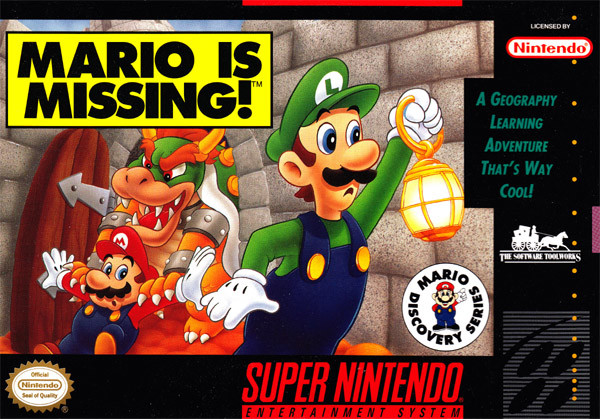
Well, I hope you played a good game, but I won't judge if you needed to take in a Super NES title and learn about geography at the same time.
NEWS
ULTRA STREET FIGHTER IV'S NEW CHARACTER IS THE ONE WE PREDICTED, FEARED
Well, this looks cool. Apparently Ultra Street Fighter IV will include a create-a-fighter mode where you can build your own character using pieces of other Street Fighters! For an example of this feature in action, CAPCOM showed off a customized Cammy named “Decapre.”
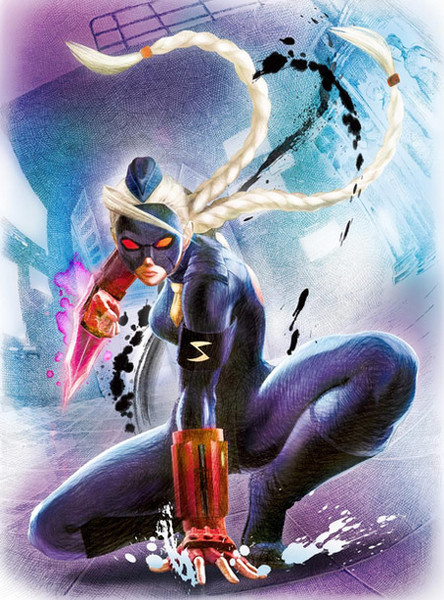
Wait. Hang on. It seems that Ultra Street Fighter IV does not contain a character-creation mode. Decapre is actually the last addition to the game's five new characters, four of whom come from Street Fighter X Tekken: Rolento, Elena, Poison, and Hugo. Decapre is…well, a Cammy clone in both appearances and backstory. She's another of the brainwashed Doll assassins cultivated by the insidious M. Bison. As such, she looks like Cammy and the previously playable Dolls named Juni and Juli, though Decapre comes with a mask, spiked gauntlets, and a vaguely Russian accent. If Street Fighter were a toy line, Decapre would be the repurposed mail-away figure that you could get with four proofs-of-purchase and $2.95 for shipping.
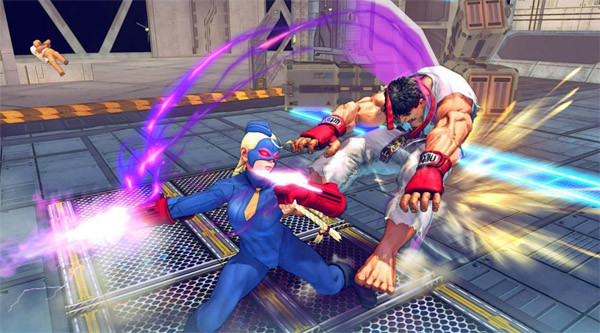
Decapre also shares a bit of Cammy's animation, though she's not so much of a knock-off in that sense. Her moves, mostly done with charge motions, are primarily for offense, and one of her Ultra attacks is a slow-moving ball of psycho power that just saunters across the screen. She can teleport and dash all over the place, and already hardcore players call her overpowered.
Other fans are too busy griping about all the Street Fighter and Final Fight characters that CAPCOM could've included instead of Evil Cammy (they're not even changing her hair?), but those just weren't as economical. We can still complain, though! Everyone pick your Top Three Better Choices Than Decapre! Mine are Maki, Skullomania, and the Warrior-King from the Street Fighter cartoon!
GUILTY GEAR XRD'S BOSS IS PLAYABLE, FAMILIAR
Like Ultra Street Fighter IV, Guilty Gear Xrd is not above repackaging old characters as new ones. The game's boss is one Ramlethal Valentine, and she looks like a white-haired, gaudily accessorized version of Guilty Gear 2: Overture's primary antagonist, Valentine. This resemblance is noted both by the game's characters and its backstory, which introduces Ramlethal as an inhuman entity spawned in the Backyard, the Guilty Gear franchise's nebulous realm of magical energy and plot twists.

Ramlethal will be playable in the next update for Guilty Gear Xrd, which is currently making its way through Japan's arcades. Her two swords figure prominently into her attacks, and she can spew a nasty, screen-filling laser. Like past Guilty Gear bosses made playable, you can look forward to her player-controlled form being about one-tenth as vicious as her boss incarnation. That's just part of how these games work.

It's a little harder to complain about Ramlethal than it is to complain about Decapre, since few people's hopes hinged on Ramlethal's debut. Still, her inclusion highlights how many regular Guilty Gear characters are conspicuously absent from Xrd. Counting Ramlethal and newcomer Bedman (above), the roster has 14 faces, and it's missing Jam Kuradoberi, Bridget, Anji, Baiken, Johnny, Testament, Zappa, and A.B.A. And as long as Arc System Works is importing names from Overture, why not add Sin, Izuna, and Dr. Paradigm? Yes, no matter what character is excluded, someone will complain. That's another part of how these games work.
IGARASHI LEAVES KONAMI, AND IT'S ABOUT TIME
For nearly a decade, Koji Igarashi was The Man Who Made Castlevania. He wasn't the creator, having joined the series somewhere between his “special thanks” in Rondo of Blood and his co-director role in Symphony of the Night. Yet he was the producer who spoke for the series throughout the 2000s, defining the whole explorative “Metroidvania” formula and taking the games in new directions. He booted titles from Castlevania canon, laid down a new franchise origin story, and perhaps rankled a few fans who longed for the tougher, slower Castlevanias of old. And now Igarashi is no longer with Konami.
On March 15, Igarashi left the company, telling IGN that he wanted “to have the freedom to make the kind of games I really want to make—the same kind I think fans of my past games want as well.”
This comes after several years of curious distance between Igarashi and Castlevania. The series grew meeker after the massive flop of the Castlevania: Judgment fighting game in 2008, even though that same year saw Order of Ecclesia, the best Castlevania since Symphony of the Night. Igarashi's last work with a Castlevania was the pieced-together Harmony of Despair in 2011, and he's since labored on social games and disposable guff like Otomedius. The series he once shepherded turned into Castlevania: Lords of Shadow, but Konami seems done with that spin-off as well. Whatever Castlevania does in the future, it won't have Igarashi aboard.
What does Igarashi have in store? A Kickstarter for a Castlevania resurrection that skirts the boundaries of lawsuits? A stylish Metroidvania in an all-new setting? A spiritual sequel to Nano Breaker? You can ask him yourself if you're going to the Game Developers Conference this year. He'll talk about Metroidvania and others things on Friday.
STRIDER VS. STRIDER
Strider isn't the biggest, longest, or proudest series in CAPCOM's catalog, but its cult following can't be denied. It's driven by a certain mystique, a future-ninja style that wins fans over even today. So CAPCOM and Double Helix had a legacy to maintain when they brought a new Strider to the PlayStation 3, PlayStation 4, Xbox One, Xbox 360, and PC. It's a legacy of bizarre bosses, brief and bombastic dialogue, and picky, picky fans. As one of those fans, I can't help pitting this new Strider against its predecessors.
STRIDER VS. ARCADE STRIDER
The original Strider is a bold piece of work for a 1989 arcade game. CAPCOM envisioned Strider as a three-part franchise hitting the arcade, the NES, and the manga market, but director Kouichi Yotsui's arcade game largely ignored the other two branches. It's a weirdly fantastic creation that sends the ninja-like Strider Hiryu slicing through the forces of Master Meio, a dictator who's marshalled everything from robot gorillas to flying battleships to dinosaurs to anti-gravity mines to a mechanical millipede formed from a Soviet parliament.
It's hardly a polished game, of course. Glitches pop up, it's easy to take hits, and Hiryu's fixed-arc leaps lack a certain ninja agility. It's also as short as any arcade side-scroller of the era, lasting under an hour if you're good enough. And yet it's a remarkable oddity, an adventure that leaps from one grand scene to another, and that lands it above just about all of its contemporaries.
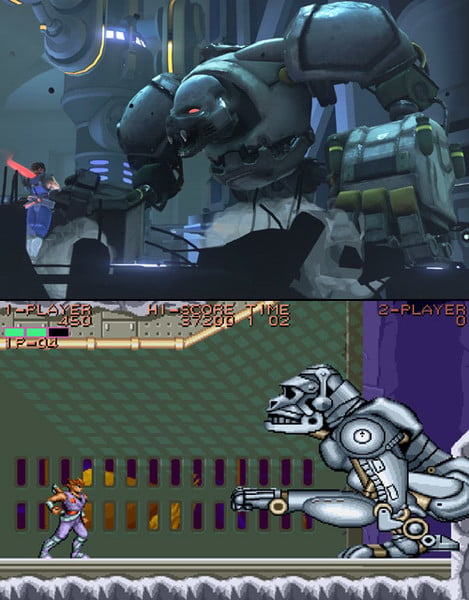
The new Strider builds itself primarily on the original arcade game. Hiryu's still an elite operative sent to destroy the Master, and all sorts of strangeness stands between them. Many familiar faces from the original Strider reappear: the mecha-ape fills the screen once again, and a trio of identical Chinese assassins is now a lineup of four reoccurring bosses. Much of the new Strider reflects the original's first level: a future Kazakhstan dominated by mechanical soldiers and the Master's toadying subordinates.
Yet it's not quite the same. While the new Strider keeps up a constant sense of speed, it forces itself to last longer, thus padding things out with the same lineup of lumbering simian mecha and automated soldiers. Some of them carry shields, some of them snipe with lasers, and a lot of them look like the main character from Saber Rider and the Star Sheriffs. Even when they change to more generic Vanquish-like cyber-suits, they're still a repetitive lot. Much of the game lacks the original's variety and impact. While the new Strider has moments of undeniable grandeur, most of the hallways and rooftops are mundane territory.
In other respects, the Strider rebirth improves on the arcade originator. The control is far more fluid than the 1989 Hiryu's stiff motions, even though Double Helix made the questionable choice of making you play a console side-scroller with analog control (oddly, Kouichi Yotsui's Moon Diver made the same mistake). Even so, it doesn't have the original's sense of risk, that breakneck air of throwing yourself at a robot dino or a bellowing amazon warrior, slashing for all you're worth, and hoping that your enemy will go down first.
STRIDER VS. NES STRIDER
If the arcade Strider is a touch untidy, the NES version of Strider is a room-wrecking monster. Based closely on the Strider manga, the NES game turns Hiryu into the tragic investigator of a plot at the heart of his Strider organization. He travels the world, learns new abilities, uncovers new levels, and watches most of his friends die in one of the bleaker tales seen on Nintendo's little box. It was a unique creation in the NES days, when non-linear Metroid play and actual storylines were fairly uncommon. Oddly, it was only released in North America despite its manga roots, and there it holds a certain fascination for children of the Nintendo Empire. It's still a mess, though.
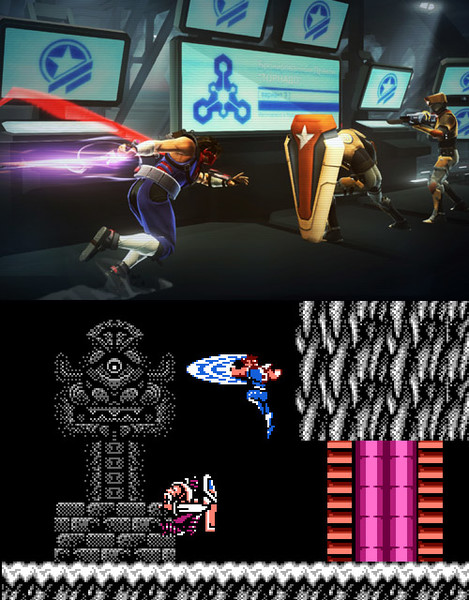
The new Strider cleans up a lot of the NES game's ideas. Hiryu scours levels for upgrades and new weapons, and most of them help unlock new areas. Stages sprawl out in various directions, and little POW icons (a classic CAPCOM symbol) hide production art and other bonuses in out-of-the-way places. Exploring is made all the easier with Hiryu's new abilities, ranging from a mid-air dash to chargeable strikes to fire-and-ice cipher blades.
That said, the latest Strider doesn't have the NES version's cosmopolitan allure. Clumsy as it could be, NES Strider sent players across the globe, exploring pyramids and jungles and an orbital station. This modern Strider confines itself largely to the Master's base city, and while it's a huge city with a lot to see, it's not quite the same.
Nor is there much of a storyline beyond the introductions of bosses. The new Strider has Hiryu working alone, occasionally bantering with bosses or background allies, and there's no sign of internal Strider discord or doomed comrades. Double Helix built their Strider for speed and trimmed all plot threads accordingly. It's a brisk tale, but not a memorable one.
STRIDER VS. STRIDER RETURNS: JOURNEY FROM DARKNESS
And how does this new Strider fare when matched against Strider Returns: Journey From Darkness, Tamtex's long-ignored Sega Genesis and Amiga sequel from the early 1990s?

The new Strider is better in every way. Next category, please.
STRIDER VS. STRIDER 2
The latest Strider has much common with Strider 2, a 1999 sequel from CAPCOM's own team. Like this present-day Strider, Strider 2 tries to evoke the original's style while carving out new ground, and it partly succeeds. The game looks sharp, controls well, and dreams up some new opposition for Hiryu in the form of cyborg mammoths, jointed machine dragons, and a rival Strider. However, it stumbles elsewhere: the game lurches when it should glide, most of the new bosses are unmemorable, and a system of on-the-spot continues makes things either too easy or too hard.
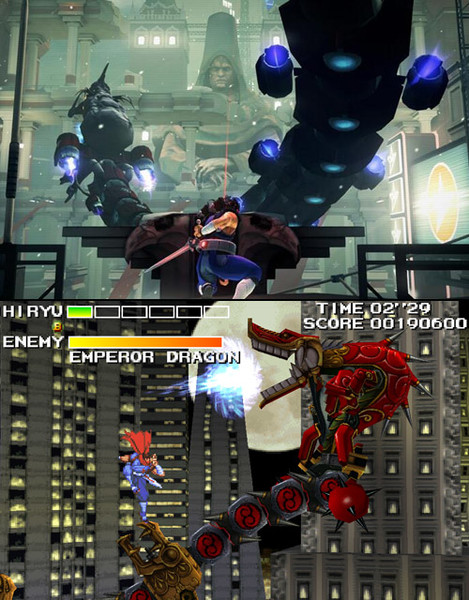
Our new Strider avoids many of the same problems. Its continue system is fair, and its pacing is far smoother. It nods to Strider 2 many times (even in Tong Poo's post-fight banter with Hiryu), and it seems to take the troubled sequel's aims to better ground. Hiryu is just as agile here as he was in Strider 2, and the tributes are all more accomplished. Strider 2 was content to merely revive old standards, but the new Strider puts them to much better use, particularly when it comes to toying with gravity. Hiryu can stay airborne much longer in the current Strider, and the game's floating-field sections are some of its most enjoyable.
STRIDER VS. ITSELF
It's unfair to liken Strider to its ancestors at every point. The new Strider is playing on a modern stage, where a new game can't get away with being a hectic 45-minute arcade rush or a jumbled mass of manga intrigue. It must stand on its own merits.
And in that light, Strider isn't such a disappointment. In terms of play mechanics, it's probably the best Strider around. Once you've adjusted to the analog interface, Hiryu becomes the sleek instrument of destruction he was always supposed to be, and his arsenal is impressive and easily accessed. Double Helix nails the sense of speed that's essential to this sort of side-scroller, and it's often fun just to zip around and mess with the physics of a futuristic super-ninja.

Strider suffers from repetition in its enemy layouts and level design, but it's not without satisfying scenes. The boss battles are solid (if sometimes drawn-out), and some of the game's best challenges are in the stage design, whether it's a room of gravity-generating satellites or a dance through laser beams and electric barricades.
CAPCOM's Strider revival lacks the impact of its predecessor. It doesn't have the cinematic soul, the crude charm, or the luxury of a bygone era's simpler standards. Yet it keeps the tradition of a sturdy, enjoyable side-scroller driven by strange sights and tightly wound action. And that's what a Strider game needs to be most of all.
NEXT WEEK'S RELEASES
BLAZBLUE: CHRONO PHANTASMA Developer: Arc System Works
Developer: Arc System WorksPublisher: Aksys Games Platform: PlayStation 3 Release Date: March 25 Pronounced: Blorz-Bliex MSRP: $49.99/$79.99 (special edition) BlazBlue is more prolific than one might think. Sure, Chrono Phantasma is only the third major chunk of BlazBlue, but the series extends through two revisions of BlazBlue: Continuum Shift as well as spin-offs like BlayzBloo and Xblaze Code: Embryo. That's a lot of BlazBlue. So what makes Chrono Phantasma the next big step in BlazBlue evolution? Seven new characters, a new three-part story arc, and numerous changes to an already complex fighting system. These enhancements aren't without their costs, however. The new storylines go deeper into BlazBlue's crazed realm of warring post-apocalyptic factions and monstrous experiments, but it no longer affords each character a story all their own. Likewise, the gameplay improvements are often replacements: the Crush Trigger, which lets players break an opponent's blocking, takes over for the Guard Crush maneuver, and the game's Heat Gauge reflects the cost of a Crush Trigger. Instead of Break Bursts, characters now use Overdrive maneuvers to gain new moves and hit harder. An Overdrive lasts longer if players activate it when they're hurting, and using one even stops the match timer. Some of the small details are appreciated, too. There's a glossary of terms, and players can preview their color palettes in full on the character-selection screen. I've wanted a feature like that ever since that time I was stuck playing a piss-yellow Jon Talbain in Night Warriors. Yet it's the new fighters that sell Chrono Phantasma. Amane Nishiki fashions his flowing robes into weapons, mercenary Bullet favors grab attacks, the fistfighter Azrael's copious tattoos grant him overpowering strength, Izayoi is an “awakened” and largely new version of Continuum Shift's Tsubaki, the general Kagura Mutsuki switches fighting stances in battle, and the generally evil Yuki Terumi can attack his opponents' Heat Gauges. And then there's the scientist Kokonoe, long requested as a playable character. Several tournaments have already banned her and her overpowered attacks. Naturally, BlazBlue: Chrono Phantasma still goes to extremes in its anime atmosphere. The characters are re-drawn here and there, the soundtrack sports remixes alongside new themes, and the whole thing practically glows with delightful gaudiness. Should you be a big enough fan of this, the special edition includes a soundtrack, a poster, a Nendoroid figure of Rachel Alucard , and a Blu-Ray of interviews and special features.
|
DECEPTION IV: BLOOD TIES Developer: Tecmo KOEI
Developer: Tecmo KOEI Publisher: Tecmo KOEI Platform: PlayStation 3/Vita Release Date: March 25 Trapt: No MSRP: $59.99 (PS3) $39.99 (Vita) The original Tecmo's Deception: Invitation to Darkness was a little pocket of pure malice in a comparatively heroic PlayStation lineup of Tomb Raiders and Resident Evils. It saw players making pacts with the Devil, furnishing a castle with gruesome traps, and claiming the souls and bodies of unfortunate visitors. The series continued through two sequels and the oddly named Trapt, turning the player's avatar into a fetching heroine for each title. This brings us to Deception IV, technically the fifth in the series. It's also not labeled Tecmo's Deception, since the company isn't as possessive as they were in 1996. Deception IV: Blood Ties finds the Devil stewing in spiritual captivity, seeking a dozen holy writs that will set him free. It falls to Laegrinna, a woman spawned from the Devil's very soul, to find these texts and murder any interlopers with novel trickery. Aided by three demon servants of varying temperaments, our anti-heroine lays traps in castles, ruins, factories, amusement parks, and other locations. Her arsenal starts with the building blocks of deceit and torment: iron maidens, swinging blades, buzzsaws, spikes, pits, springboards, precarious chandeliers, and all sorts of objects that fall on victims' heads. But the lineup expands into more elaborate contraptions like miniature locomotives and an entire carnival carousel. Laegrinna still engages her foes face-to-face, and she can launch an “enrage beam” to confound their senses and make them all the more likely to stumble into a springboard that hurls them into a cannon, which launches them into a bonfire, which drops an enormous pumpkin on their head, which leads them into the path of a giant yo-yo. It's all a bit weird and downright disturbing in some cases (particularly when the victims are scantily clad women), but Tecmo's never lied about what the Deception series entails.
|
THE WITCH AND THE HUNDRED KNIGHT Developer: Nippon Ichi Software
Developer: Nippon Ichi Software Publisher: NIS America Platform: PlayStation 3 Release Date: March 25 Witchery: Legal MSRP: $49.99 Yes, that's Hundred Knight, not Hundred Knights. It makes a little bit of sense in context. The Knight in question is a legendary creature that supposedly wields massive weapons and commands a legion of armored warriors (hence the “Hundred”), but in practice it's a little blob of dark energy given sentience and armor. The irascible swamp witch Metallia learns as much when she summons up the creature and sends it off on violent errands. It's part of her plot to make all of the surrounding lands as fetid and inhospitable as her marshy home turf—which she adores, as though she's a My Little Pony villain. She's accompanied by a mechanical servant, an admiring satyr astrologer and a witch-hunter cursed with a doglike visage. Metallia's war is primarily against her Forest Witch rival, but there's a procession of other sorceresses to get in the way: a Flame Witch, a Dust Witch, a Fog Witch, a Pumpkin Witch, a Thin Ice Witch, and a Scum Witch. I suppose someone has to be the Scum Witch. Yet the impish Hundred Knight is Metallia's main weapon, and that's who the player controls on numerous forays throughout the kingdom of Medea. The little soldier dashes around and hacks at enemies in primitive action-RPG fashion at first, but the arsenal of moves, stat-boosts, and attacks expands, letting the Hundred Knight pull off combo strikes with five different weapons. While warping around the territory, the Knight can take on various quests for Metallia as well as other characters. As a servant of an ambitiously rotten witch, the Knight is free to attack common citizens and raid their homes for treasures, but too many ill deeds will turn neutral villagers and travelers into enemies. And you'll have no one to blame but yourself. For those who enjoy special-edition gewgaws, The Witch and the Hundred Knight is available in a collector's set with an art book, a two-disc soundtrack, and a little Nendoroid Petite figure of Metallia (with a removable hat!), and a box to hold it all. However, only NISA's website officially sells this collector's edition, and it's sold out there. Perhaps I shouldn't have mentioned it.
|
Dynasty Warriors 8 Xtreme Legends expands the most recent Dynasty Warriors in various little ways. Each character gets another EX attack, more bodyguards, extra weapons, and a level cap of 150. Five new playable characters join the cast, and there's a new story mode focusing on the oft-pursued Lu Bu. Most welcome is a cross-play feature that lets the Vita, PlayStation 3, and PlayStation 4 versions of the game share saves and multiplayer sessions.
discuss this in the forum (20 posts) |
this article has been modified since it was originally posted; see change history